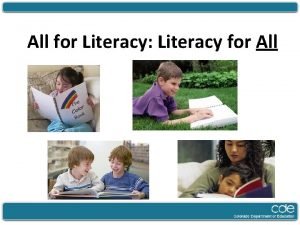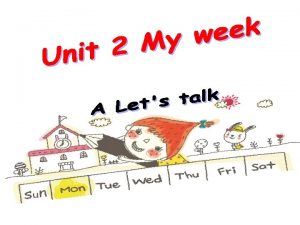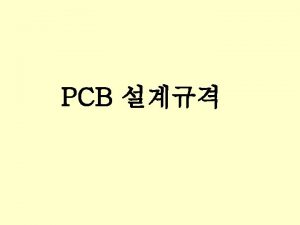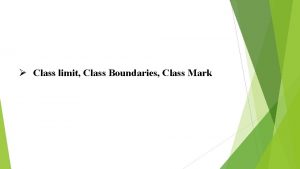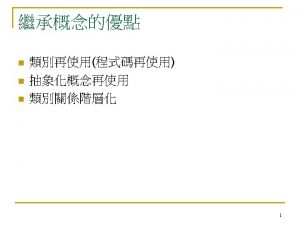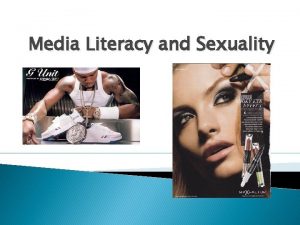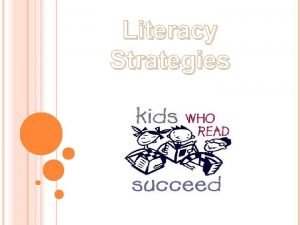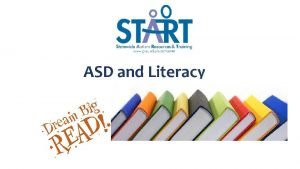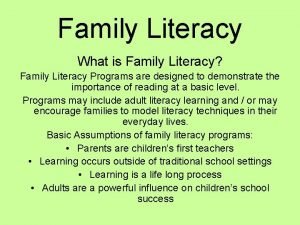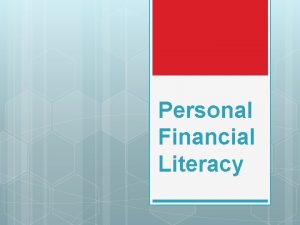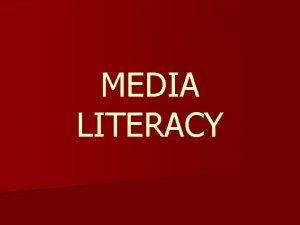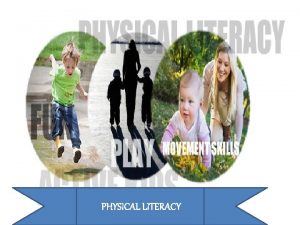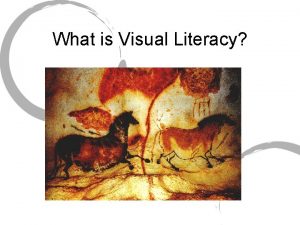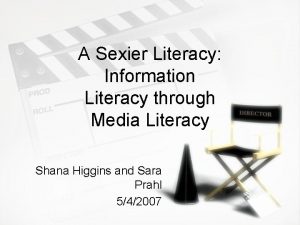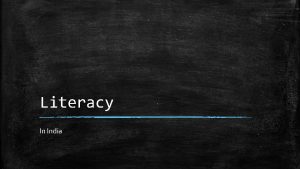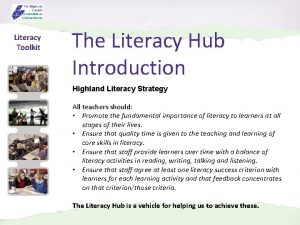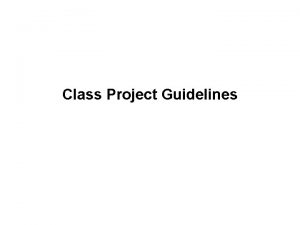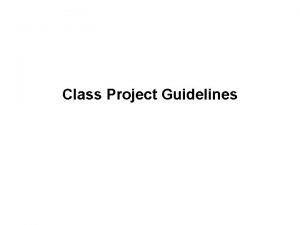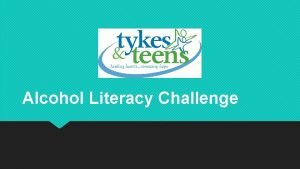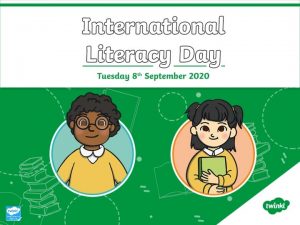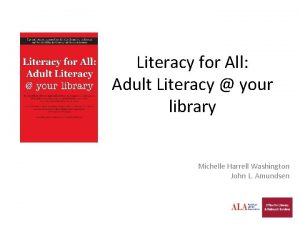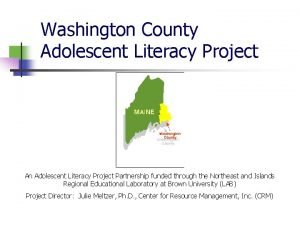Literacy is for All Literacy Project Class 1


































- Slides: 34

Literacy is for All Literacy Project, Class 1 WI FACETS

What is Literacy?

Literacy is. . . 3

Traditional Model of Literacy Learning Re g n i d a Writ Readiness Skills ing Speaking Listening Erickson, 1999 4

Other signs of literacy might be… �Recognizing pictures or common words �Choosing books to be read �Showing awareness of being read to �Paying attention to the reader �Tracking print 5

Goals for Today ØGet to know the basics of the reading process ØUnderstand the components (parts) of literacy ØLearn skills to support each component ØTake away activities you can do with your child at home.

Reading is a Complex Process Not ALL students with disabilities will master ALL components of reading �A student with Central Auditory Processing Disorder or other communication disorder may have difficulty with phonics. �Students with a reading disability, such as dyslexia, may need “unique” instruction based on the effects of the disability. �A student with a language disability or an attention deficit may have difficulty with reading comprehension. �A student with significant Cerebral Palsy might not be a fluent oral reader.

What helps struggling readers? Ø Current research shows that the majority of children who struggle in reading can learn to read IF: Ø We identify (as early as possible!) that the student has difficulty Ø The specific reading problem is correctly identified and Ø Effective reading methods are used over a long period of time. practice… practice!

ALL students have a right to… ØHave access to the general curriculum ØBased on State Standards ØUnless the IEP team decides to use alternate standards ØBe educated using peer-reviewed research based practices “to the extent practicable”

If needed by the student, literacy instruction MUST be a part of the IEP!

And YOU are YOUR Child’s Best Advocate!

Know the Language of Reading!

Components of Reading � Phonemic Awareness � Phonics � Fluency � Vocabulary Development � Text Comprehension What do these terms mean and what do these skills have to do with a child becoming a good reader?

Phonemic Awareness. . . is knowing the sounds of language. ◦Words are made up of speech sounds, or phonemes. ◦Before children learn to read print, they need to become aware of how the sounds in words work. Individual sounds are called phonemes

Phonemes The smallest parts of sound in a spoken word that make a difference in the word’s meaning. “Hat” has three sounds or phonemes: h/a/t §For example, changing the first phoneme in the word hat from /h/to /b/ changes the word from hat to bat, and so changes the meaning of the word.

Phonemic Awareness Students need to learn: � The spoken word consists of sounds: phonemes � How words can be: 1. segmented (pulled apart) into sounds � How sounds can be 1. blended (put back together) 2. manipulated (added, deleted & substituted) � How to use their phonemic awareness to blend sounds to read words and to segment sounds in words to spell them.

Phonemic Awareness What Parents Can Do �Play clapping, rhyming and “what do you hear? ” games with your child. �Ask your child to see how many words they can think of that start with a specific sound, such as the /sss/, /m/ or /ch/ sound. �Play with sounds in all parts of words (beginning, middle, and end): like "job, " "jot, " and "jog, " where the difference is at the end of the words. �Make up silly sentences with words that begin with the same sound, such as "Nobody was nice to Nancy's neighbor". *Some tips are from Reading Rockets ecac 2013

Phonics is the knowledge of how letters represent sounds. � phonemes ◦ the sounds of spoken language and � graphemes ◦ the letters and spellings that represent those sounds in written language. Understanding these relationships gives children the ability to recognize familiar words quickly and to read and spell words they haven’t seen before.

Phonics Students need to learn: � Accurate and rapid identification of letter sounds � The alphabetic principle �an understanding that the sequence of sounds (phonemes) in a spoken word are represented by letters in a written word � Phonics elements and how to apply them as they read and write �Letter-sound correspondences �Spelling patterns �Syllables �Meaningful word parts

P h o n i c s Phonics What Parents Can Do ØPoint to letters and letter combinations and ask your child to name their sounds. ØSay a sound ask your child to tell you the letter the sound represents. ØLook for words on signs, maps, billboards, cereal boxes, money, and birthday cards. Point out words to your child wherever you see them. Say them out loud. ØEncourage your child to write notes, e-mails, and letters. ØTalk with your child about the “irregular” words; such as, said, are, and was, that he needs to recognize “by sight. ”

Fluency is the ability to read a text accurately and quickly. Fluency provides a bridge between word recognition and reading comprehension.

Fluency Students need to learn: � How to decode isolated words accurately � How to read connected text automatically with appropriate: ◦ Speed ◦ Accuracy and ◦ Expression! ecac 2013

Fluency What Parents Can Do �Help your child sound out words they don’t know. �You read the page first and have your child follow along. �Listen to your child read the same pages repeatedly until your child smooths out all the "bumps in the road. " Reading those favorite books over and over again. �Have your child read into a tape recorder a number of times and then listen to the recording �Practice, Practice! ecac 2013

Vocabulary Development Vocabulary means the words we must know to be able to communicate well ◦ Oral vocabulary refers to words that we use in speaking or recognize in listening. ◦ Reading vocabulary refers to words we recognize or use in print.

Vocabulary Development Students need to learn: � The meanings for most of the words in a text � How to apply a variety of strategies to learn word meanings � How to make connections between words and concepts � How to accurately use words in oral and written language ecac 2013

Vocabulary Development What Parents Can Do Ø Lots of conversation. Ø Lots of shared reading and conversation about specific words. Ø Use magnets on the refrigerator. Create and discuss new words with your child. Ø Study and learn word parts. If your child knows the meaning of a root word (“kind”), then he’ll know what the new word means when the prefix (“un”/not) or suffix (“ness”/state of being) is added. (unkind, kindness). Ø Talk about the relationships between words. Words with the same or similar meanings (“bucket/pail”), and opposites (“good/bad”).

Text comprehension Comprehension is the understanding of what is read Comprehension is the reason for reading. If readers can read the words, but do not understand what they are reading, they are not really reading.

Text Comprehension Students need to learn how to: � Read both narrative (stories) and expository (factual) texts � Understand remember what they read � Relate their own knowledge or experiences to text. For example, if you are reading a book about a school field trip, ask your child to share about a field trip they have been on and how their experience was similar or different. � Use comprehension strategies � Communicate with others about what they read

Text Comprehension What Parents Can Do � Use”retelling”: Have your child read a page or story to you and retell everything they can remember. � Discuss what your child has read. Ask your child probing questions about the book and connect the events to his or her own life. � Give your child many background experiences. The more experiences a child has had, the more he can connect what he is reading to what he knows.

Literacy really IS for ALL! To review: The 5 Components are: Phonemic Awareness Phonics Fluency Vocabulary Development Text Comprehension

Support Literacy At Home

Support Literacy At Home – Read 10 more minutes a day!

Support Literacy At Home �CHALLENGE: �Read 10 more minutes per day; 5 days per week �Print out a calendar and record the # of minutes you read each day �Try at least one activity from “Building Literacy with Everyday Activities”

CONTACT US www. wifacets. org Main Office: 600 W. Virginia Street, Suite 501 Milwaukee, WI 53204 Phone: (414) 374 -4645
 Name 3 points
Name 3 points Media literacy vs information literacy
Media literacy vs information literacy Media and information literacy venn diagram
Media and information literacy venn diagram Sample of people in media
Sample of people in media Cyber literacy for the digital age
Cyber literacy for the digital age Kontinuitetshantering
Kontinuitetshantering Novell typiska drag
Novell typiska drag Nationell inriktning för artificiell intelligens
Nationell inriktning för artificiell intelligens Returpilarna
Returpilarna Varför kallas perioden 1918-1939 för mellankrigstiden?
Varför kallas perioden 1918-1939 för mellankrigstiden? En lathund för arbete med kontinuitetshantering
En lathund för arbete med kontinuitetshantering Underlag för särskild löneskatt på pensionskostnader
Underlag för särskild löneskatt på pensionskostnader Personlig tidbok fylla i
Personlig tidbok fylla i A gastrica
A gastrica Vad är densitet
Vad är densitet Datorkunskap för nybörjare
Datorkunskap för nybörjare Boverket ka
Boverket ka Hur skriver man en debattartikel
Hur skriver man en debattartikel Delegerande ledarskap
Delegerande ledarskap Nyckelkompetenser för livslångt lärande
Nyckelkompetenser för livslångt lärande Påbyggnader för flakfordon
Påbyggnader för flakfordon Vätsketryck formel
Vätsketryck formel Publik sektor
Publik sektor Bo bergman jag fryser om dina händer
Bo bergman jag fryser om dina händer Presentera för publik crossboss
Presentera för publik crossboss Jiddisch
Jiddisch Bat mitza
Bat mitza Treserva lathund
Treserva lathund Epiteltyper
Epiteltyper Claes martinsson
Claes martinsson Cks
Cks Verifikationsplan
Verifikationsplan Mat för unga idrottare
Mat för unga idrottare Verktyg för automatisering av utbetalningar
Verktyg för automatisering av utbetalningar Rutin för avvikelsehantering
Rutin för avvikelsehantering




































